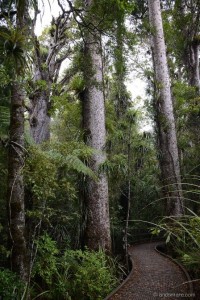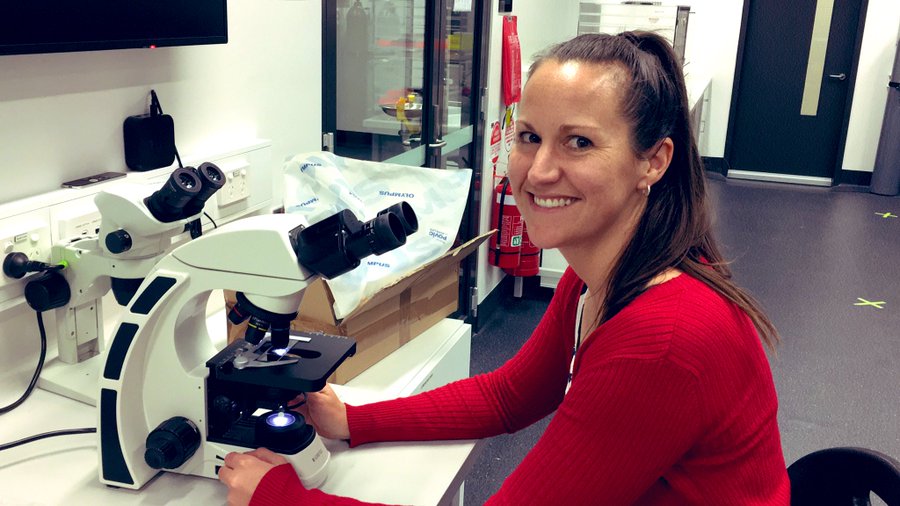By Ignacio Jara
Since the 1980’s a huge amount of time and effort has been put to build a climate-sensitive tree-ring chronology for New Zealand. A noteworthy achievement of this scientific effort was the publication in 2006 of two independent tree-ring chronologies, a 2,300-year record from Silver Pine (Lagarostrobos colensoi) and a 3,700-year chronology from Kauri (Agathis australis) (1). Since 2006, the kauri chronology has been refined and extended up to 4,500 years, becoming one of the longest tree-ring records from the Southern Hemisphere (2). To generate such a long series, Kauri wood samples were collected from more than 60 sites across its whole distribution range in northern New Zealand; including modern trees, archaeological sites and sub-fossil trees preserved in swamp areas (that is a lot of annual tree rings to count!).
Figure 1: The present-day distribution of Kauri forest in northern New Zealand has been severely reduced by centuries of human forestry and farming. In the picture a remnant Kauri forest patch. Photo courtesy of Andamare.com
But perhaps what makes this chronology most scientifically relevant is that the dominant driver behind the present-day Kauri radial growth is El Nino Southern Oscillation (ENSO (3)). Wider tree-rings tend to occur during the relatively dry/cold El Nino years, while narrower rings are observed during the warmer/wetter La Nina years. This ENSO-kauri correlation seems to be strong throughout the entire distribution range of kauri forest, which facilitates a robust ENSO signal even if samples from multiple areas are integrated.
The potential of using the kauri chronology to decipher the waxing and waning of ENSO at timescales longer that the period instrumental record has been fully exploit in a recent publication in the journal Nature Climate Change (3). Focussing in the last 700 years of the chronology, the period with the highest statistical quality, the published ENSO reconstruction clearly depicts the twentieth century as the most “ENSO active” period in the context of the last 400 years. However, a high ENSO activity period is observed between 1,300 and 1,450 AD.
Figure 2: The 700-years kauri-based ENSO reconstruction (in blue) in conjunction with other ENSO reconstruction from the Tropical Pacific. Image taken from Fowler et al 2012 (reference #2).
By comparing this tree-ring reconstruction with other ENSO proxies from the core of ENSO activity in the tropical Pacific, the authors further investigate the climate connection between the tropics and New Zealand (Figure 2). Relatively low variation in the kauri-based record compared with the tropical ENSO reconstructions between 1300-1750 AD suggests a reduced ENSO-New Zealand connection during the so-called Little Ice Age period. Interestingly, the authors point out that a northward shift of the Southern Westerly Winds and the subtropical front – a miniature version of a climate shift previously identified during the last Glaciation- could have resulted in a northward movement of the ENSO-south Pacific connection, pulling it away from northern New Zealand and therefore explaining the differences between these reconstructions observed during the Little Ice Age. Unfortunately, a confident ENSO reconstruction using the whole extend of the Kauri chronology is still impossible as some segments of the 4,500-year tree-ring record do not have enough samples to provide a statistically significant interpretation (2).
ENSO is one of the most influential modes of climate variation in the world. Abrupt annual anomalies in its behaviour can have a large impact on ecosystems and societies around the Pacific. For instance, in western South America -where ENSO was first identified- El Nino years are associated with very wet and warm conditions, as well as with a reduction in the upwelling of nutrient rich waters along the Pacific coast, with devastating effects on the local ecosystem and the local fishing industry. While in Queensland, Australia – the opposite side of the Pacific- El Nino is associated with drier conditions, which are linked to droughts, fires and mass coral bleaching on the Great Barrier Reef. The biggest question then is how ENSO behaviour might be affected by future global warming. Will the ENSO mode of variation be enhanced, will it increase in frequency, or will be unaffected, or reduced? Over the last few decades (pretty much the whole extension of the ENSO instrumental record), there has been an increase in ENSO activity associated with the warming trend observed during that same period. The continuation of this trend in the future is uncertain since coupled atmospheric-ocean models suggest contrasting results. This highlights the importance of developing high-resolution paleoclimate records able to investigate past associations between temperature changes and ENSO activity during the Holocene and beyond.
References
1. E. R. Cook, B. M. Buckley, J. G. Palmer, P. Fenwick, M. J. Peterson, G. Boswijk, A. Fowler, Millennia-long tree-ring records from Tasmania and New Zealand: a basis for modelling climate variability and forcing, past, present and future. Journal of Quaternary Science 21, 689-699 (2006)10.1002/jqs.1071).
2. G. Boswijk, A. M. Fowler, J. G. Palmer, P. Fenwick, A. Hogg, A. Lorrey, J. Wunder, The late Holocene kauri chronology: assessing the potential of a 4500-year record for palaeoclimate reconstruction. Quaternary Science Reviews 90, 128-142 (2014); published online Epub4/15/ (http://dx.doi.org/10.1016/j.quascirev.2014.02.022).
3. A. M. Fowler, G. Boswijk, A. M. Lorrey, J. Gergis, M. Pirie, S. P. J. McCloskey, J. G. Palmer, J. Wunder, Multi-centennial tree-ring record of ENSO-related activity in New Zealand. Nature Clim. Change 2, 172-176 (2012); published online Epub03//print (http://www.nature.com/nclimate/journal/v2/n3/abs/nclimate1374.html#supplementary-information).


